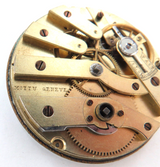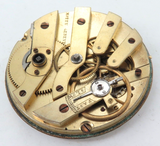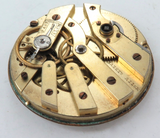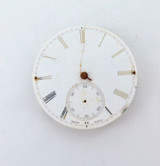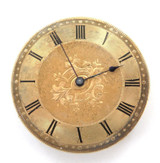Description
Scarce 1800s Mottu, Geneva Key Wind Slim Line Mens Pocket Watch Movement & Dial
Currently not working, appears the mainspring is broken, balance is good, good clean movement. It will need a repair to get going. Dial is in poor condition & is approx 40mm in diameter. Sold without a key.
Local Brisbane pick-up welcomed. Always happy to combine postage where possible & practical. HNCO are not responsible for import duties or customs charges. This is the buyers / importers responsibility.
~~~~~~~~~~~~~~~~~~~~~~~~~~~~~~~~~~~~~~~~~~~
HNCO is one of the leading sellers of Pocket watches on eBay Australia, with over 100+ Pocket watches on offer. We are constantly adding to our ever increasing range and have a large assortment of American Railroad Grade Pocket Watches.
American Railroad Pocket watches were amongst the highest grade watches made, having been made for the railways makes them a great choice to use every day, mainly for their durability over time. Their lower production quantities and of course their high grade movements make them also a great gift or investment.
A typical railroad's requirements for a pocket watch in the early 20th century might include:
* Only American-made watches may be used (depending on availability of spare parts).
* Only open-faced dials, with the stem at 12 o'clock.
* Minimum of 17 functional jewels in the movement.
* Size 16 or 18 only.
* Maximum variation of 30 seconds (approximately 4 seconds daily) per weekly check.
* Watch adjusted to at least five positions: Face up and face down (the positions a watch might commonly take when laid on a flat surface); then crown up, crown pointing left, and crown pointing right (the positions a watch might commonly take in a pocket). Occasionally a sixth position, crown pointing down, would be included.
* Adjusted for severe temperature variance and isochronism (variance in spring tension)
* Indication of time with bold legible Arabic numerals, outer minute division, second dial, heavy hands.
* Lever used to set the time (no risk of inadvertently setting the watch to an erroneous time, when winding the watch with the stem)
* Breguet balance spring
* Micrometer adjustment regulator
* Double roller escapement
* Steel escape wheel
* Anti-magnetic protection (after the advent of diesel-electric locomotives)
The minimum requirements were raised several times as watch-making technology progressed, and the watch companies produced newer, even more reliable models. By WW2, many railroads required watches that were of a much higher grade (as many as 23 jewels, for example) than those made to comply with the original 1891 standard.
_gsrx_vers_1608 (GS 9.5 (1608))


